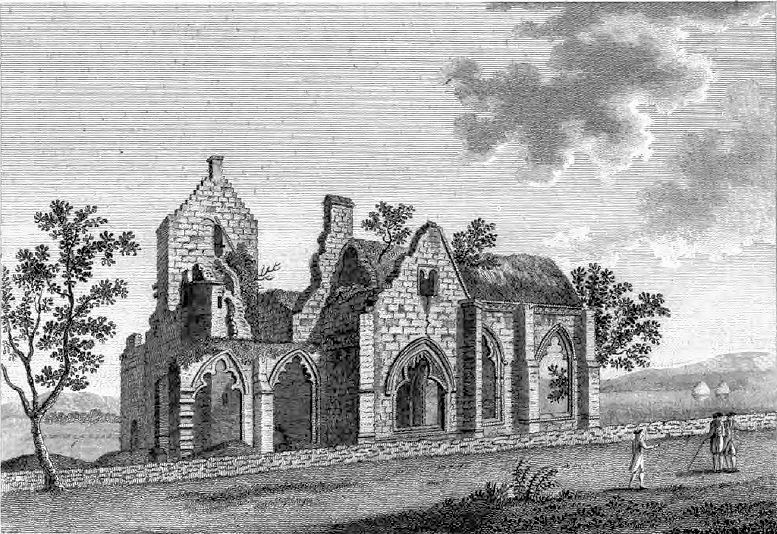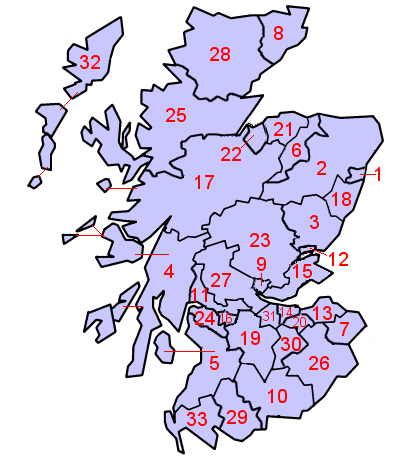|
Troqueer
Troqueer is a former village and a parish in the historic county of Kirkcudbrightshire in Dumfries and Galloway on the west side of the River Nith. The eastern-side was merged with Dumfries to the east in 1929, and today eastern Troqueer is a suburb of Dumfries. Location Troqueer lies on the west side of the Nith, and was originally in Kirkcudbrightshire. The parish has an area of including the former burgh of Maxwelltown in the northeastern portion. It is about from north to south and from east to west, and is bordered on the east by the Nith. An 1846 account said the parish included some woodland and plantations, but was mainly arable, meadow, and pasture. It went on: "The surface is intersected by three nearly equidistant and parallel ranges of heights, the first of which, rising gradually from the river, has been long in a high state of cultivation, and contains several nursery grounds and gardens of great fertility. The valley between it and the second ridge is also frui ... [...More Info...] [...Related Items...] OR: [Wikipedia] [Google] [Baidu] |
List Of Listed Buildings In Troqueer, Dumfries And Galloway ...
This is a list of listed buildings in the civil parish of Troqueer in Dumfries and Galloway, Scotland. List Key Notes References * All entries, addresses and coordinates are based on data froHistoric Scotland This data falls under thOpen Government Licence {{DEFAULTSORT:List of listed buildings in Troqueer, Dumfries and Galloway Troqueer Troqueer is a former village and a parish in the historic county of Kirkcudbrightshire in Dumfries and Galloway on the west side of the River Nith. The eastern-side was merged with Dumfries to the east in 1929, and today eastern Troqueer is a sub ... [...More Info...] [...Related Items...] OR: [Wikipedia] [Google] [Baidu] |
Dumfries
Dumfries ( ; ; from ) is a market town and former royal burgh in Dumfries and Galloway, Scotland, near the mouth of the River Nith on the Solway Firth, from the Anglo-Scottish border. Dumfries is the county town of the Counties of Scotland, historic county of Dumfriesshire. Before becoming King of Scots, Robert the Bruce killed his rival John Comyn III of Badenoch at Greyfriars Kirk in the town in 1306. The Young Pretender had his headquarters here towards the end of 1745. In World War II, the Norwegian armed forces in exile in Britain largely consisted of a brigade in Dumfries. Dumfries is nicknamed ''Queen of the South''. This is also the name of the town's Queen of the South F.C., football club. People from Dumfries are known colloquially in Scots language as ''Doonhamers''. Toponymy There are a number of theories on the etymology of the name, with an ultimately Common Celtic, Celtic derivation (either from Common Brittonic, Brythonic, Old Irish, Gaelic or a mixture of b ... [...More Info...] [...Related Items...] OR: [Wikipedia] [Google] [Baidu] |
John Blackadder (preacher)
John Blackadder (or Blackader) (1615–1685) was an eminent Presbyterian Covenanter preacher in Scotland during the period of the Commonwealth of England (1649–1660). Of the times MacPherson said that "after the first rejoicings of the Restoration were over, the Covenanters — Robert Douglas (minister), Resolutioners as well as James Guthrie (minister)#Resolutioners versus Protestors, Protesters — were speedily disillusioned, and it became evident that the aim of Charles II of England, Charles II and the junta of self-seeking noblemen who were in control of the affairs of Scotland was to establish in Scotland something approximating to an oriental despotism. The Presbyterian system, in which an Assembly of ministers and elders controlled the affairs of the Kirk, had to be supplanted by an Scottish Episcopal Church, Episcopal, with a hierarchy controlled by the Crown and easily manipulated in the interests of tyrannical rule." Despite a government ban he continued to pre ... [...More Info...] [...Related Items...] OR: [Wikipedia] [Google] [Baidu] |
Pict's Knowe
Pict's Knowe () is a henge monument in the parish of Troqueer, Dumfries and Galloway. It is one of a small group of henge monuments around Dumfries which includes Broadlea henge near Annan, Dumfries and Galloway, Annan. Pict's Knowe is located 4 km SW of Dumfries on a small sandy bank in the peat covered valley of the Crooks Pow stream. The site has been badly damaged by livestock, rabbit burrowing and tree rooting. The area around the monument had been occupied since the early Neolithic, but the henge itself appears to date to the early Bronze Age, based on Radiocarbon dating, radiocarbon analysis. The monument has one entrance, making it a Class I henge. It enclosed an area of 20-25m in diameter. In the entrance to the henge, sherds of a carinated urn were found, and fragments of cremated bone, which may have been animal rather than human. During the Iron Age the henge's bank was added to and the ditch recut, with a timber platform built over it. The site was scheduled ... [...More Info...] [...Related Items...] OR: [Wikipedia] [Google] [Baidu] |
Curriestanes Cursus
Curriestanes cursus () is a large neolithic ditched enclosure on the outskirts of Dumfries, in the parish of Troqueer, Dumfries and Galloway. It is visible only from aerial photography. It is, along with Pict's Knowe, one of two scheduled monuments in Troqueer parish. Description Curriestanes is an earthwork cursus. While familiar from cursus sites in England, these types of monuments are less common than timber cursuses in Scotland. Less than fifteen monuments of this type have been found in Scotland and only five including Curriestanes have been excavated. Curriestanes is rare in having an entrance gap in one of its terminals, a feature known from only a handful of sites in the UK. The cursus is particularly wide at 100m, with a known area of at least three hectares. Only 3 other cursus monuments in Scotland are wider: East Linton, Brioch and Monktonhill. The ditches are irregular and do not appear to have been intended to be exactly straight which suggests that they may have ... [...More Info...] [...Related Items...] OR: [Wikipedia] [Google] [Baidu] |
Kirkcudbrightshire
Kirkcudbrightshire ( ) or the County of Kirkcudbright or the Stewartry of Kirkcudbright is one of the Counties of Scotland, historic counties of Scotland, covering an area in the south-west of the country. Until 1975, Kirkcudbrightshire was an counties of Scotland, administrative county used for local government in Scotland, local government. Since 1975, the area has formed part of Dumfries and Galloway for local government purposes. Kirkcudbrightshire continues to be used as a registration county for land registration. A lower-tier districts of Scotland, district called Stewartry covered the majority of the historic county from 1975 to 1996. The area of Stewartry district is still used as a lieutenancy areas of Scotland, lieutenancy area. Dumfries and Galloway Council also has a Stewartry area committee. Kirkcudbrightshire forms the eastern part of the medieval lordship of Galloway, which retained a degree of autonomy until it was fully absorbed by Scotland in the 13th century. ... [...More Info...] [...Related Items...] OR: [Wikipedia] [Google] [Baidu] |
Maxwelltown
Maxwelltown (, IPA: �kʰʲaun̴̪ˈt̪ɾɔxətʲ was formerly a burgh of barony and police burgh and by the time of the burgh's abolition in 1929 it was the most populous burgh in the county of Kirkcudbrightshire, Scotland. In 1929 Maxwelltown was merged with the neighbouring burgh of Dumfries. Maxwelltown lies to the west of the River Nith, which forms the historic boundary between Kirkcudbrightshire and Dumfriesshire. Maxwelltown was a hamlet known as Bridgend up until 1810, in which year it was made into a burgh of barony under its present name, later becoming a police burgh in 1833. Maxwelltown comprises several suburbs, including Summerhill, Troqueer, Janefield, Lochside, Lincluden, Sandside, and Summerville. The burgh of Maxwelltown straddled the two parishes of Terregles and Troqueer. In a referendum in 1928 the residents of Maxwelltown voted to join the burgh of Dumfries. The change took effect on 3 October 1929, and also had the effect of transferring Maxwellt ... [...More Info...] [...Related Items...] OR: [Wikipedia] [Google] [Baidu] |
Nithsdale
Nithsdale (), also known as Strathnith, Stranith or Stranit, is the strath or dale (landform), dale of the River Nith in southern Scotland. Nithsdale was one of the medieval provinces of Scotland. The provinces gradually lost their administrative importance to the shires of Scotland, shires created from the twelfth century, with Nithsdale forming part of Dumfriesshire. A Nithsdale districts of Scotland, district covering a similar area to the medieval province was created in 1975, based in the area's main town of Dumfries. The district was abolished in 1996, since when the area has been directly administered by Dumfries and Galloway Council. History The name ''Strath Nid'' may represent the Cumbric ''Ystrad Nidd''; Cumbric (a variety of Common Brittonic) was the dominant language in this area from before Roman times until the 11th or 12th century, whereas Gaelic influence here was late and transient. The River Nith flows north to south through the Southern Uplands in south-wes ... [...More Info...] [...Related Items...] OR: [Wikipedia] [Google] [Baidu] |
Dumfries And Galloway
Dumfries and Galloway (; ) is one of the 32 unitary council areas of Scotland, located in the western part of the Southern Uplands. It is bordered by East Ayrshire, South Ayrshire, and South Lanarkshire to the north; Scottish Borders to the north-east; the English county of Cumbria, the Solway Firth, and the Irish Sea to the south, and the North Channel (Great Britain and Ireland), North Channel to the west. The administrative centre and largest settlement is the town of Dumfries. The second largest town is Stranraer, located to the west of Dumfries on the North Channel coast. Dumfries and Galloway corresponds to the counties of Scotland, historic shires of Dumfriesshire, Kirkcudbrightshire, and Wigtownshire, the last two of which are collectively known as Galloway. The three counties were combined in 1975 to form a single regions and districts of Scotland, region, with four districts within it. The districts were abolished in 1996, since when Dumfries and Galloway has been a ... [...More Info...] [...Related Items...] OR: [Wikipedia] [Google] [Baidu] |
Lieutenancy Areas Of Scotland
The lieutenancy areas of Scotland are the areas used for the ceremonial lord-lieutenants, the British monarch, monarch's representatives, in Scotland. The lord-lieutenants' titles chosen by the British monarch, monarch and his legal advisers are mainly based on placenames of the traditional counties of Scotland. In 1794, permanent lieutenancies were established by Warrant (law), Royal Warrant. By the Militia Act 1797 (37 Geo.3, C.103), the lieutenants appointed "for the Counties, Stewartries, Cities, and Places" were given powers to raise and command County Militia Units. While in their lieutenancies, lord lieutenants are among the few individuals in Scotland officially permitted to fly Royal Banner of Scotland, a banner of the Royal Arms of Scotland, the "Lion Rampant" as it is more commonly known. Lieutenancy areas are different from the current local government of Scotland, local government council areas and their committee areas. They also differ from other subdivisions of Sc ... [...More Info...] [...Related Items...] OR: [Wikipedia] [Google] [Baidu] |
Rosefield Mills (born 1942), American economist
{{disambiguation, geo, surname ...
Rosefield may refer to: Places * Rosefield, Saskatchewan, Canada * Rosefield, Louisiana, United States * Rosefield (Windsor, North Carolina), a plantation house * Rosefield Township, Peoria County, Illinois, United States People * Joseph L. Rosefield (1882–1958), American businessman See also * Steven Rosefielde Steven R. Rosefielde (born 1942) is professor of comparative economic systems at the University of North Carolina at Chapel Hill. He is also a member of the Russian Academy of Natural Sciences. ''Red Holocaust'' In ''Red Holocaust'', Rosefield ... [...More Info...] [...Related Items...] OR: [Wikipedia] [Google] [Baidu] |






